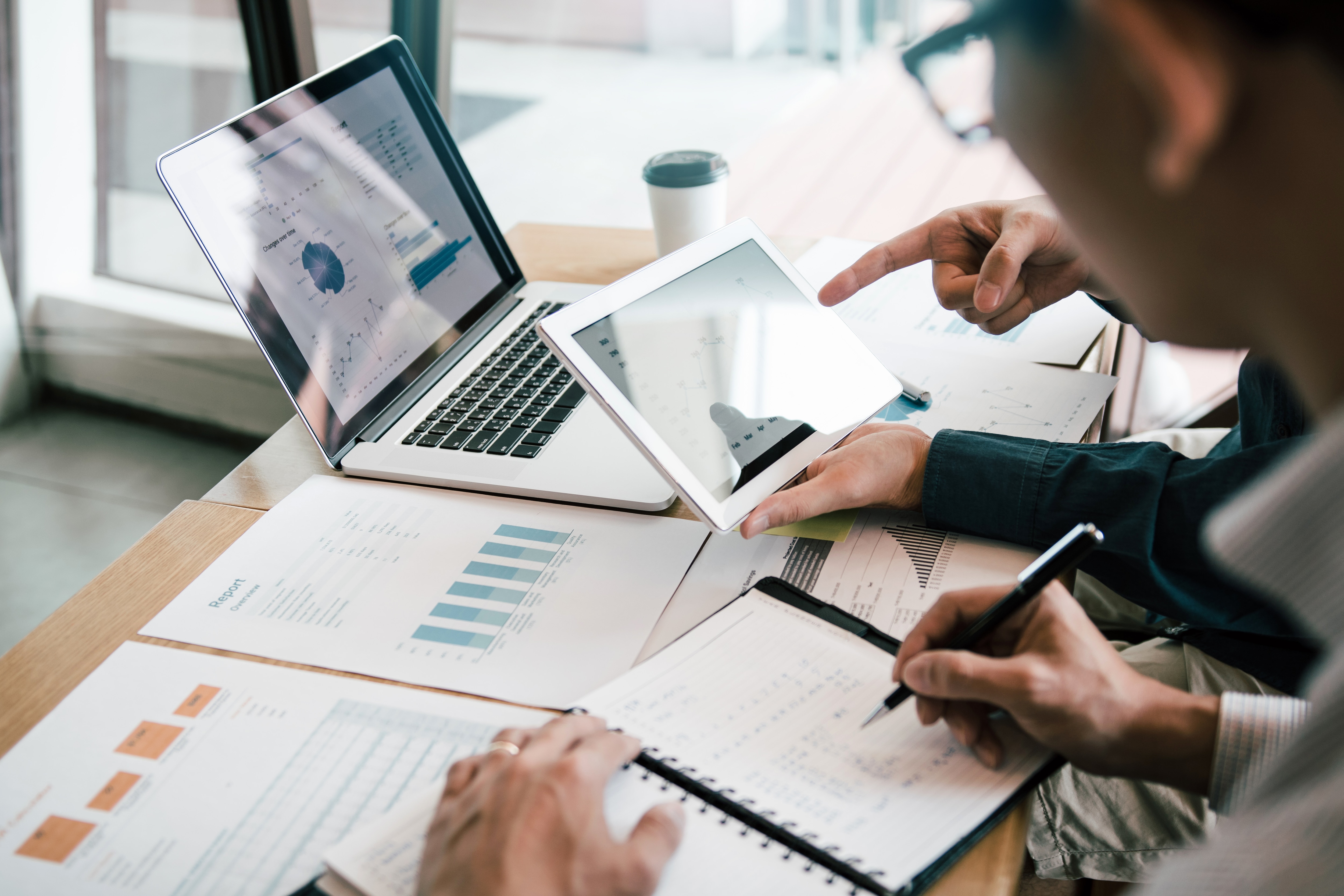The profit and loss (P&L) statement is a reporting tool you can use to assess the financial health of your company. A P&L statement shows you your overall profit or loss for a period and helps you see what specific business activities contribute to your overall results.

Profit & Loss Statements and the Health of Your Business
The Components of a P&L Statement
Whether you prepare your P&L statement or pay someone to do it for you, understanding how the report comes together can help you turn losses into profits or grow your profits even more.
These are the major components of a P&L statement:
- Sales and revenue
- Cost of revenue
- Gross margin
- Operating expenses
- Earnings before interest, taxes, depreciation, and amortization (EBITDA)
- Depreciation
- Interest
- Earnings before taxes (EBT)
- Profit or loss
Here’s what each of these categories contains and how it affects your company’s bottom line:
Sales and Revenue
Sales and revenue is a fairly straightforward category, but it’s essential to recognize that this category isn’t all about the cash you take in. While cash contributes to sales and revenue, this information appears on a different statement called the cash flow statement. This is because sales and revenue can also include items you may not have cash in the bank for yet.
For example, if you perform services for a customer and then send an invoice, you won’t have the cash for this service until the customer pays. Just looking at your monthly or annual bank statement doesn’t give you a complete picture of how much your company earns during a period, because that amount doesn’t take into account the money that’s still coming in.
Expenditures
Cost of Revenue
Cost of revenue can include the cost of goods sold (COGS) and cost of sales (COS). COGS consists of the expenses you incur to produce the products you sell. If you sell services instead of goods, this would be the COS. Your business may include both types of costs: For example, you might run a company that sells pool supplies and also offers pool cleaning services. COGS can consist of materials, labour, and shipping costs, and COS is mostly labour costs, though it can include other expenses, such as employee mileage reimbursements.
For an example of what falls under COGS, imagine you have an online retail business where you sell your handmade goods. You account for the cost of the materials you purchase to assemble and package these goods in COGS. If you hire people to help with assembly and shipping, the amount you pay them is also a COGS. Not all labour falls under the COGS, however. Say business is booming for your online business and you hire a part-time bookkeeper to help you keep track of finances. This labour cost is separate from the COGS because you cannot directly tie it to sales revenue. Instead, it goes under operating expenses.
Similarly, not all of the assets you purchase go into the COGS, even if they do directly contribute to sales. Perhaps you sell custom-printed merchandise that requires you to buy an industrial-size printer. Larger purchases like this may fall under the category of depreciable property, which is the property you expense over time.
Once you subtract your COGS or COS from sales and revenue, you have your gross margin. This total gives you a good overall idea of how profitable your core business activities of producing goods and providing services are.
Operating Costs and Small Business Payroll
Operating costs are expenses that aren’t cost of revenue or depreciation expenses. These include costs, such as your bookkeeper’s salary from the previous example, along with other administrative labour expenses, such as for labour costs for human resources and payroll employees. Other expenses that don’t directly contribute to individual sales also go here, such as office supplies and rent expenses on administrative office space.
One other exception to this is interest: If you’re paying interest on a debt or incur financing fees on a new loan, these financial expenses appear later in the P&L statement.
Earnings on Your P&L Statement
You subtract your cost of revenue and operating expenses from your sales and revenue to get your first earnings line: EBITDA. This includes your earnings before you deduct your financing costs, taxes, and depreciation and amortization expenses. Depreciation and amortization expenses are expenses you deduct for assets that serve your business over time.
Depreciation Expenses
Depreciation expenses apply to physical assets that require a relatively huge payment up front and then offer many years of use. The Canada Revenue Agency (CRA) considers these types of assets to be depreciable property . You cannot claim the entire amount you spend on the depreciable property as an expense in the first year; instead, the CRA allows you to claim a certain percentage each year based on the class of the asset.
To determine the class of depreciable property, you can consult the latest CRA guidelines for calculating capital cost allowance (CCA). CCA is just another term for allowable yearly depreciation expenses. Equipment, machinery, vehicles, and buildings all fall under multiple classes depending on how much you spend, when you purchased the asset, how you use it, and other factors.
It’s essential to look closely at the class descriptions, as many types of assets appear in several classes, and each class has its own percentage of the purchase price you can deduct each year. For example, if you purchase a vehicle, there is one of two categories it may apply to:
- Class 10 applies to most vehicles you use for business. You can expense up to 30% of the purchase price each year.
- Class 16 includes taxis and vehicles you plan to rent out to others. The depreciation amount you can expense each year is up to 40%.
Say you purchase a Class 10 vehicle for $20,000. Assume this includes any sales tax, such as Goods and Services Tax (GST) and Harmonized Sales Tax (HST), which you can include when you determine the total cost of the purchase. Multiply $20,000 by 30% to get $6,000, the maximum you can expense each year. So, if you choose to expense the maximum, your depreciation expenses look like this:
- Year one: $6,000
- Year two: $6,000
- Year three: $6,000
- Year four: $2,000
There’s only a $2,000 deduction in the fourth year because you can only deduct up to the total purchase price of the vehicle, and this example deducts $18,000 in the first three years. You don’t have to deduct the full amount each year, however: If you deduct less than the full allowable amount, you can roll over the amount you did not deduct into the next year. In the same example above, imagine you only deduct $4,000 in the first year. That means in year two you can deduct up to $8,000, which is your maximum allowable amount of $6,000, plus the rollover amount of $2,000.
Amortization Expenses
Amortization is like depreciation, but for intangible assets, such as copyrights and patents. This is an uncommon expense for small-business owners, but you may be able to claim a copyright or patent that has significant value. This value is subjective, so you may want to seek professional assistance in appraising the value of these types of assets.
Just like depreciation, amortizing an intangible asset means you deduct a percentage of the value of the asset each year as an expense. Many small-business owners who don’t have depreciation or amortization expenses just include an earnings before interest and tax (EBIT) section instead of EBITDA.
Subtracting any interest, depreciation, and amortization expenses from your EBITDA leaves you with earnings before taxes (EBT), the last line before you get your profit. But why go through the exercise of breaking out all these sections when you can quickly calculate your profit by subtracting expense from revenue?
Benefits of Using Profit & Loss Statements
Making Strategic Decisions
The first reason to use P&L statements is that they help you make better decisions about how you operate your company. Breaking revenue and expenses into subcategories enables you to see what areas are bringing in the most revenue and where you’re over- or under-spending on expenses. If you’re spending more on administrative expenses than the cost of goods sold, for example, you may want to look at cutting back on your support staff to focus on the core of your business.
Splitting out earnings into categories also helps you focus your decision-making where it makes the most impact. By looking at your gross margin, for example, you have a better idea of the amount of your bottom line you can affect by adjusting your day-to-day operations. If the difference between sales and revenue and cost of revenue isn’t where you want it to be, you may consider raising prices or negotiating lower rates with your suppliers.
Knowing the difference between gross margin and EBITDA — your earnings before you deduct interest, tax, depreciation, and amortization — helps you make decisions about how you allocate spending on overhead and administrative expenses. Say you have a large difference between gross margin and EBITDA: That means you’re spending a large amount on overhead expenses, and you might consider cutting down on employee hours or hire fewer administrative employees in the following year.
Understanding Tax Implications
The P&L statement also helps you understand and manage the tax implications of your business decisions. By splitting EBT from your profit, you can see exactly how much you’re sending to the government each year compared to the rest of your expenditures. Knowing the difference between EBITDA and EBT, or your earnings before you pay taxes, also helps you make timing decisions when you invest in your business.
This is especially true near the end of the year. If you’re considering investing in new equipment and your tax bill is quite high for the year, you may decide to go ahead and make that purchase at the end of the year. That way, you can deduct your first year of depreciation during the current tax year. There’s one catch though: You must put that equipment into production before you can start deducting expenses. You can’t just stock up on equipment you plan to use the following year and then claim a deduction.
If you do decide to create a P&L statement, there are apps and services that make it easy. These tools can also make other aspects of your business easier to manage by streamlining tasks, such as managing payroll through a payroll management system. Using an accounting system, such as QuickBooks Online, you can generate a profit and loss statement automatically. Learn how today.


